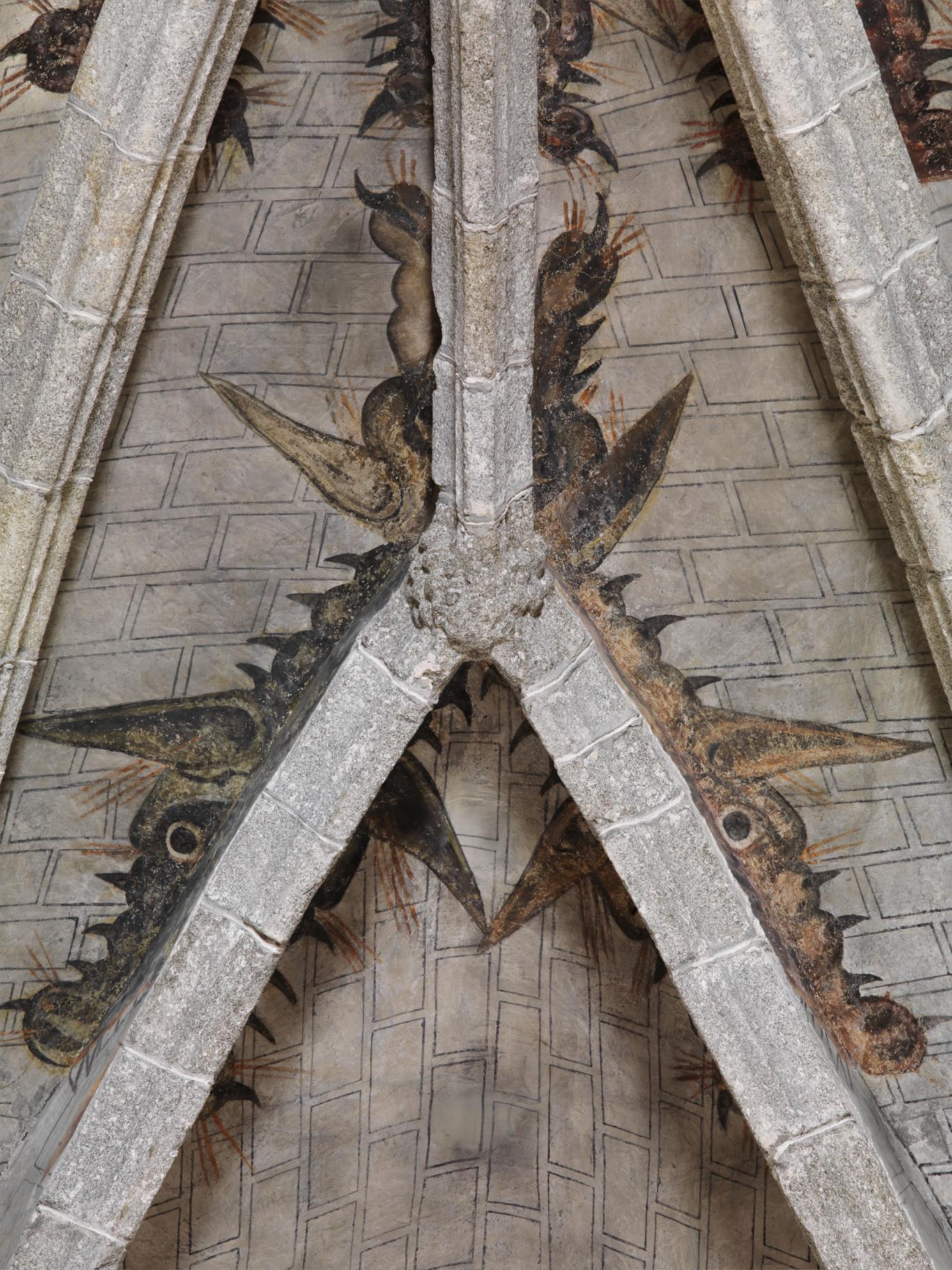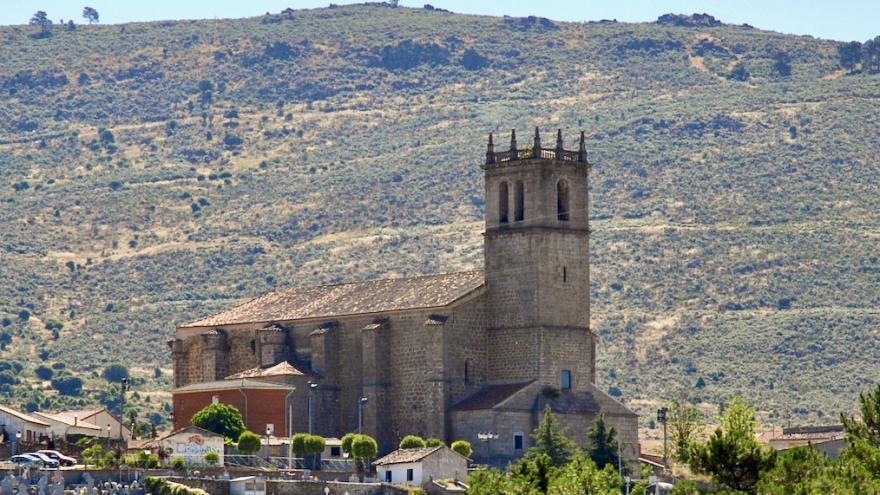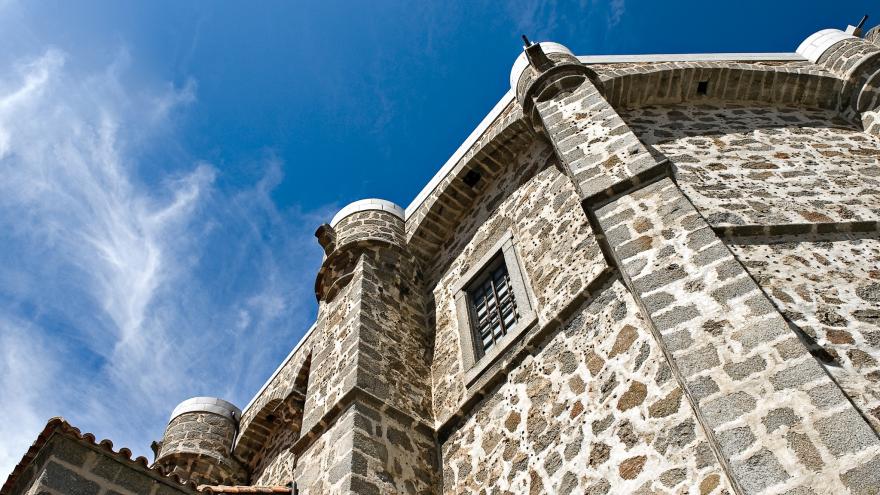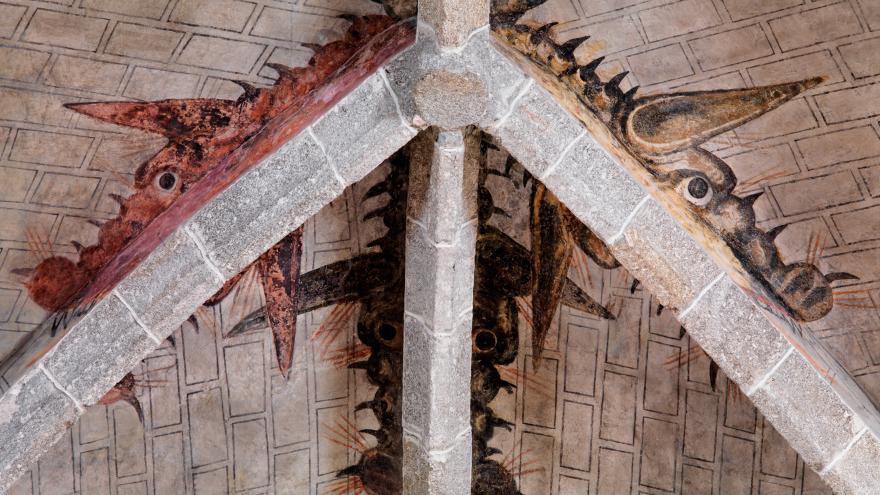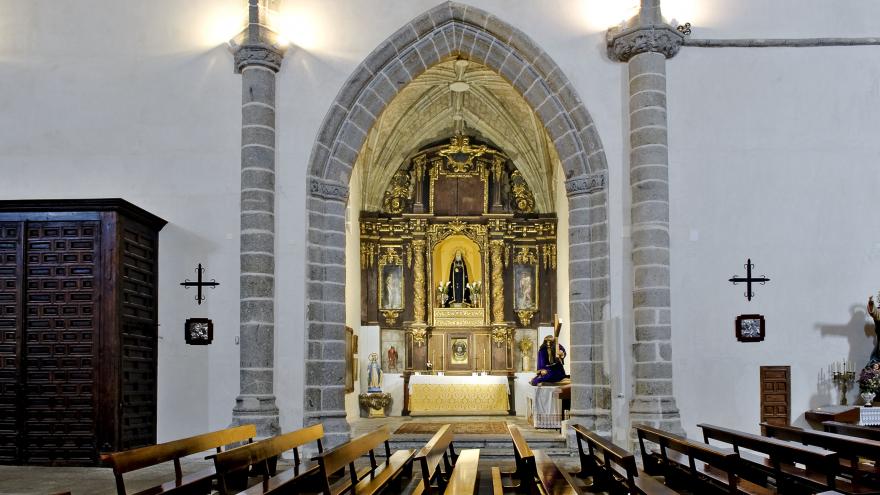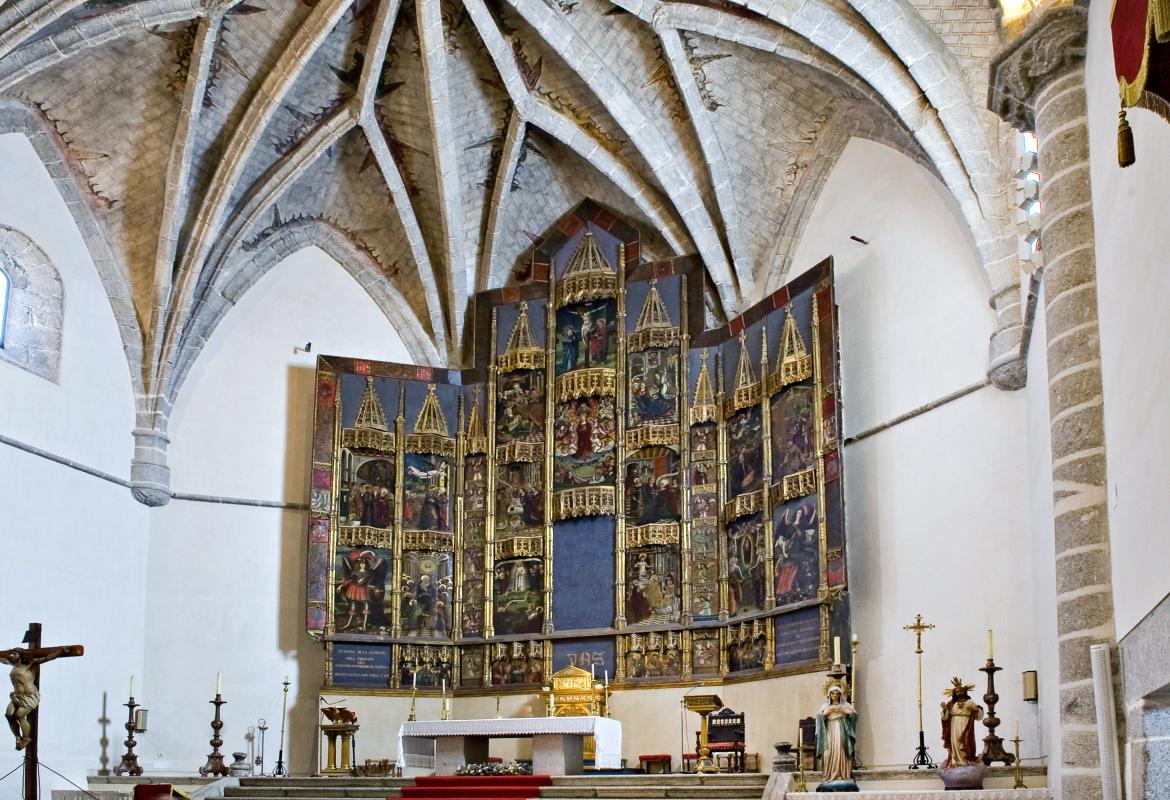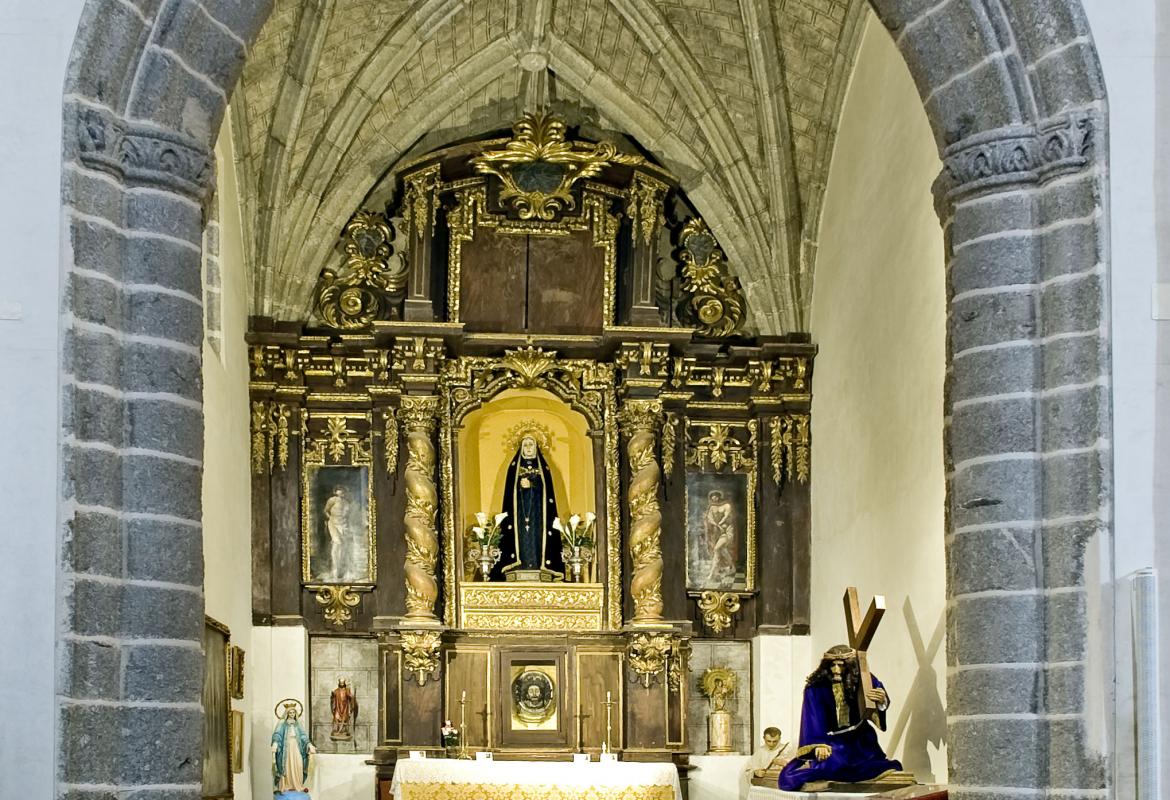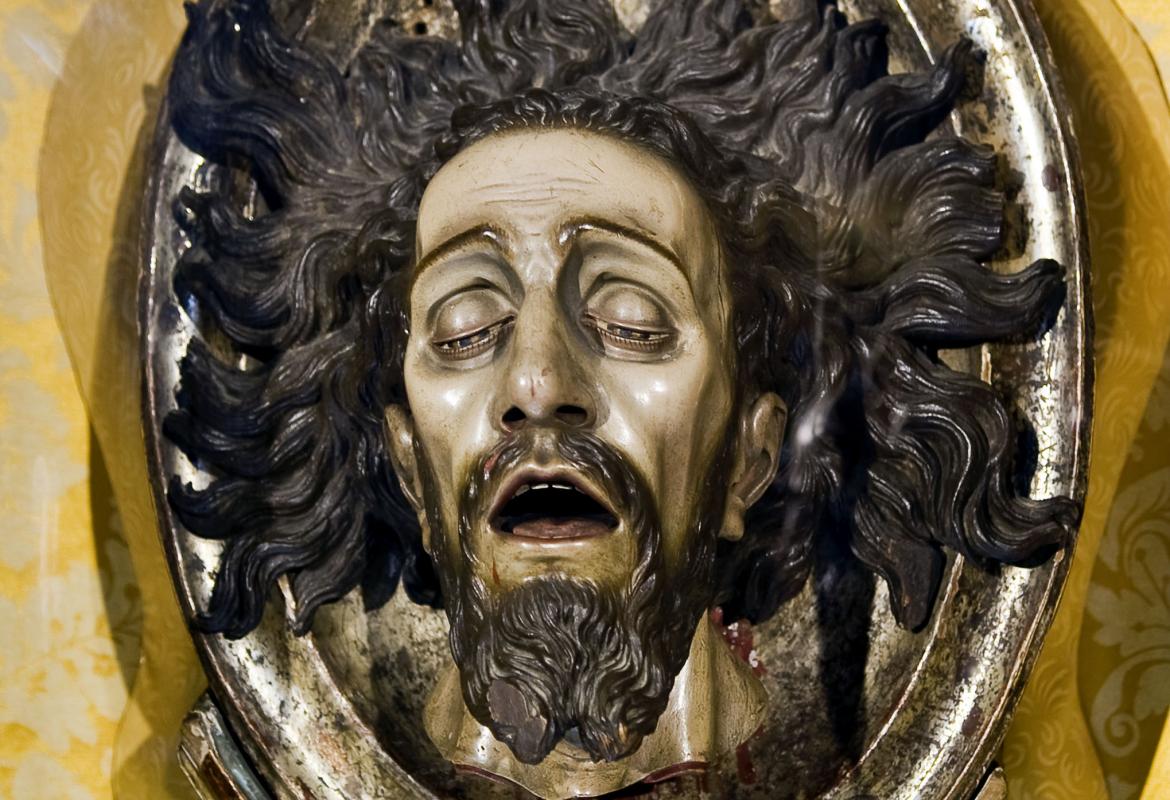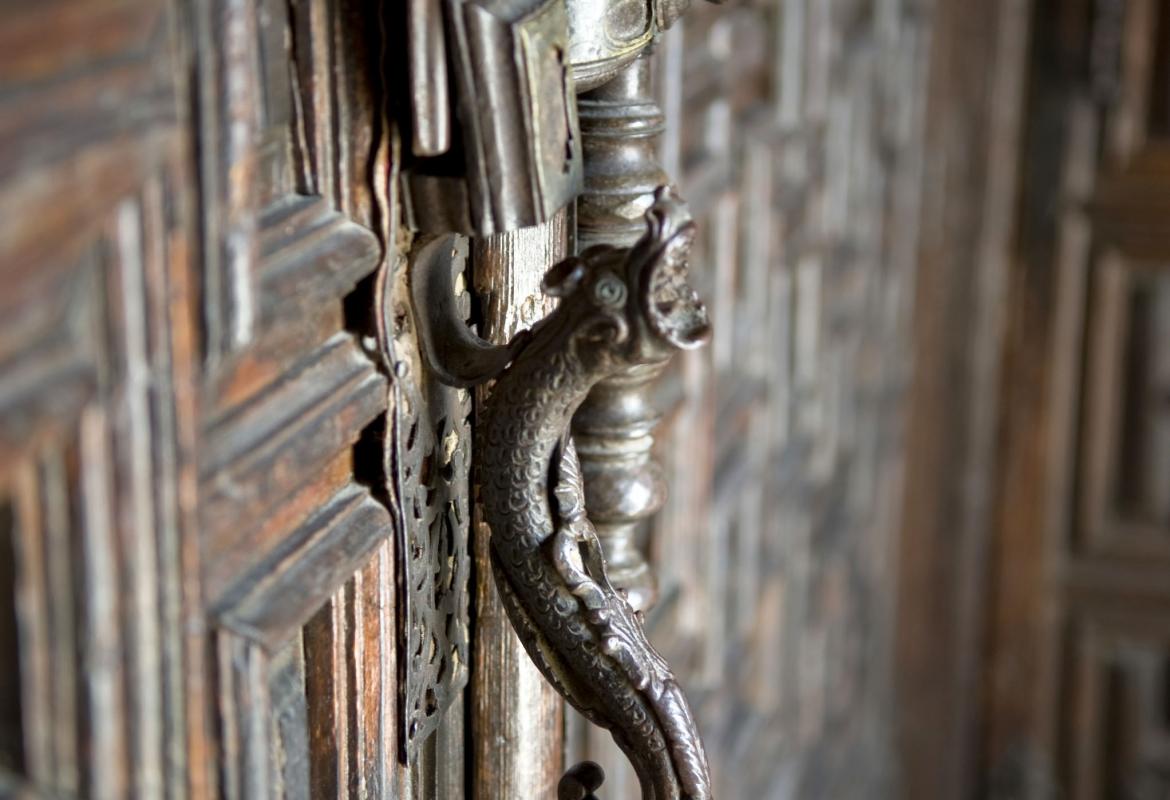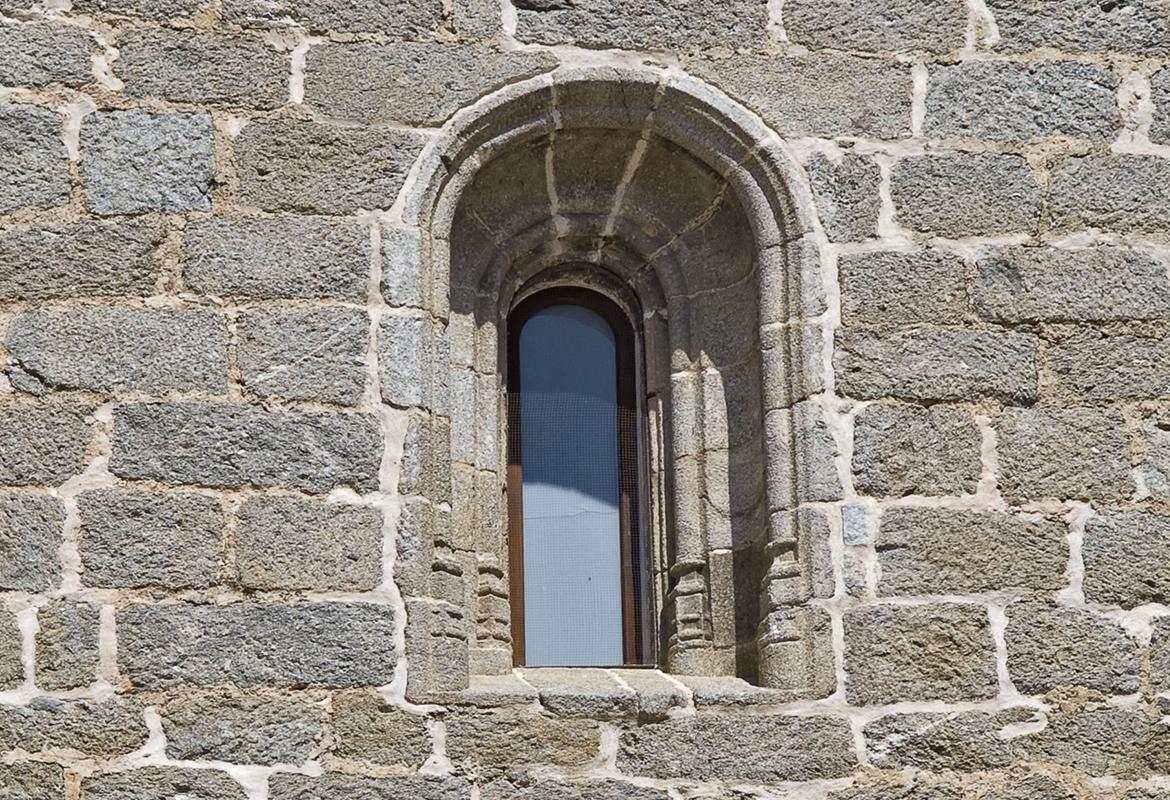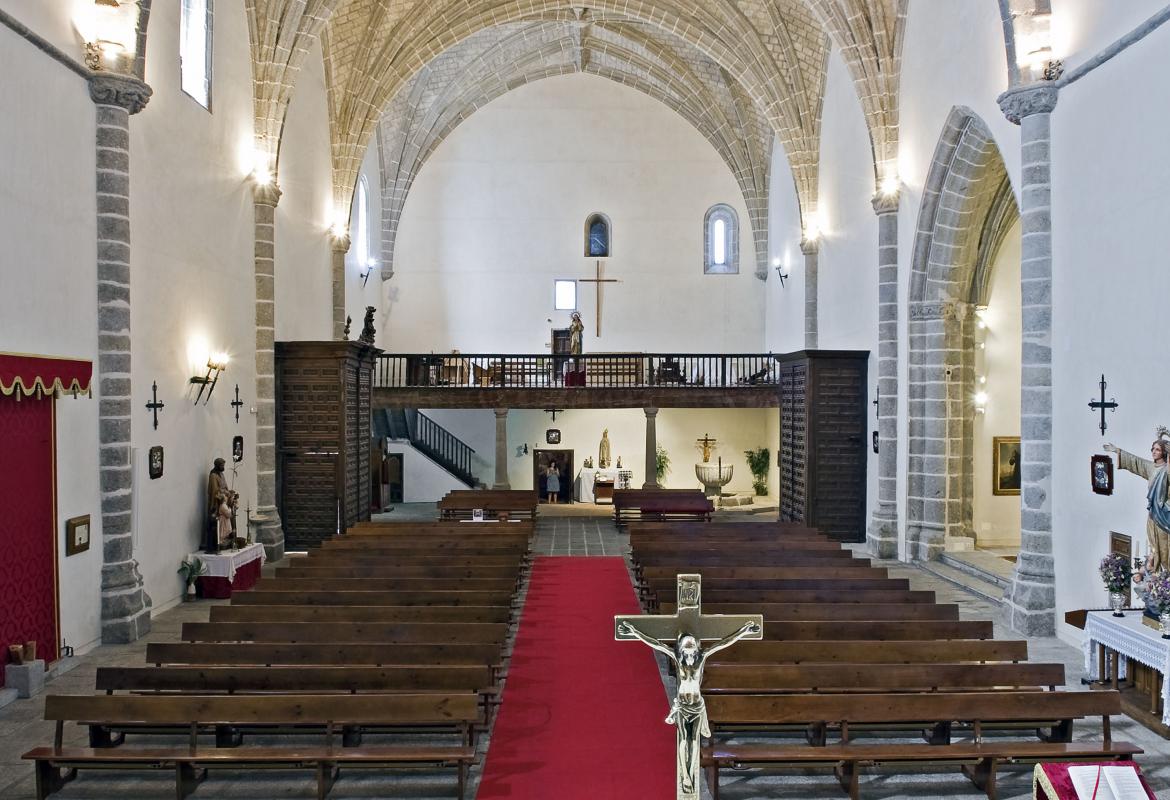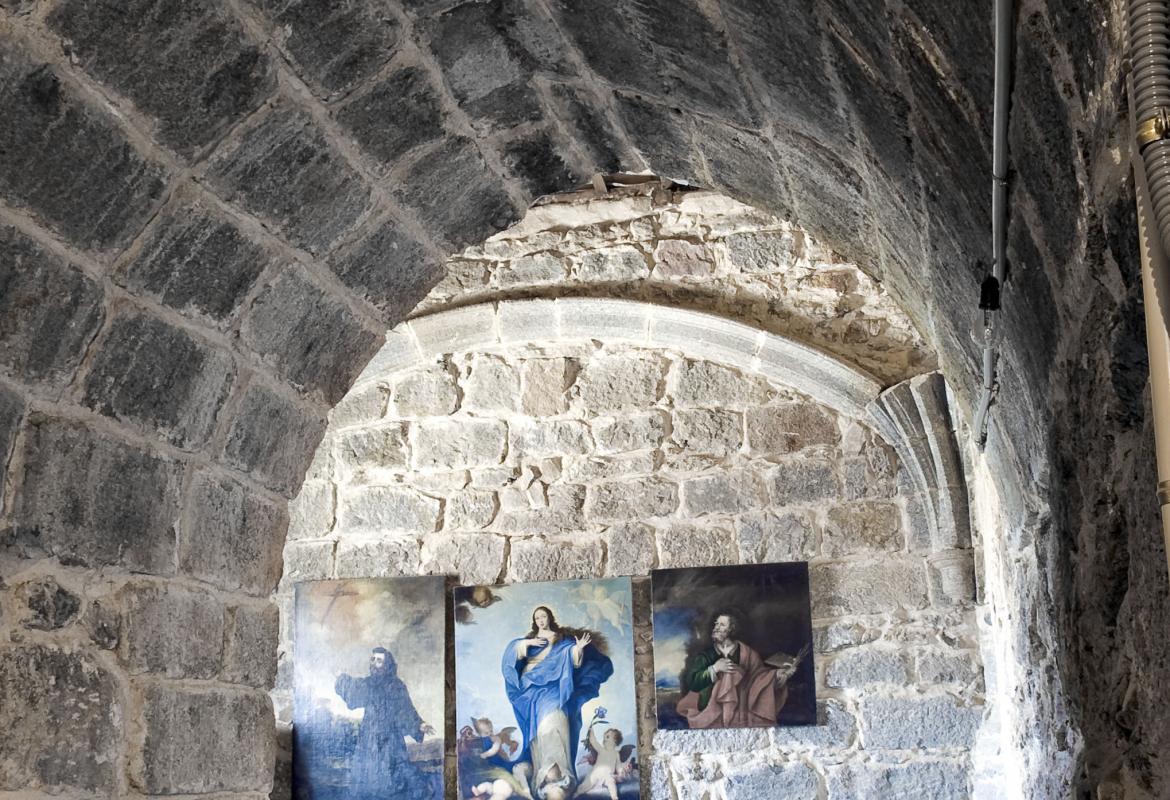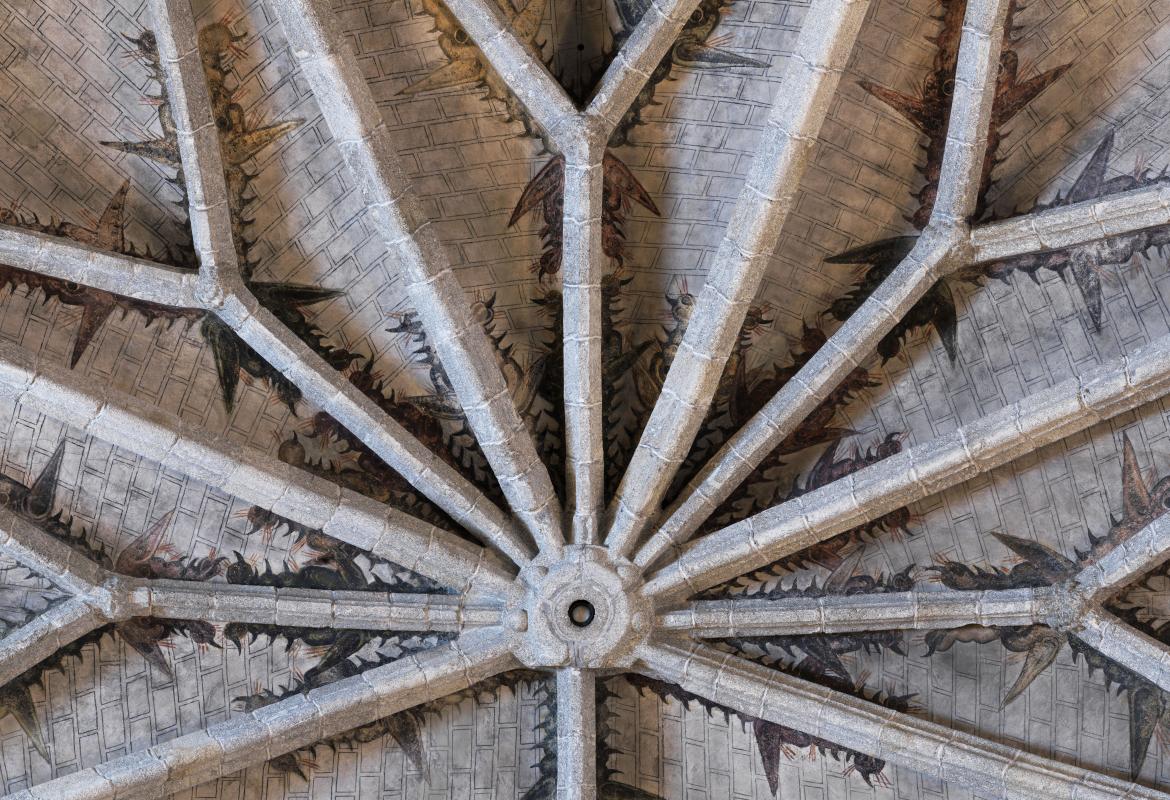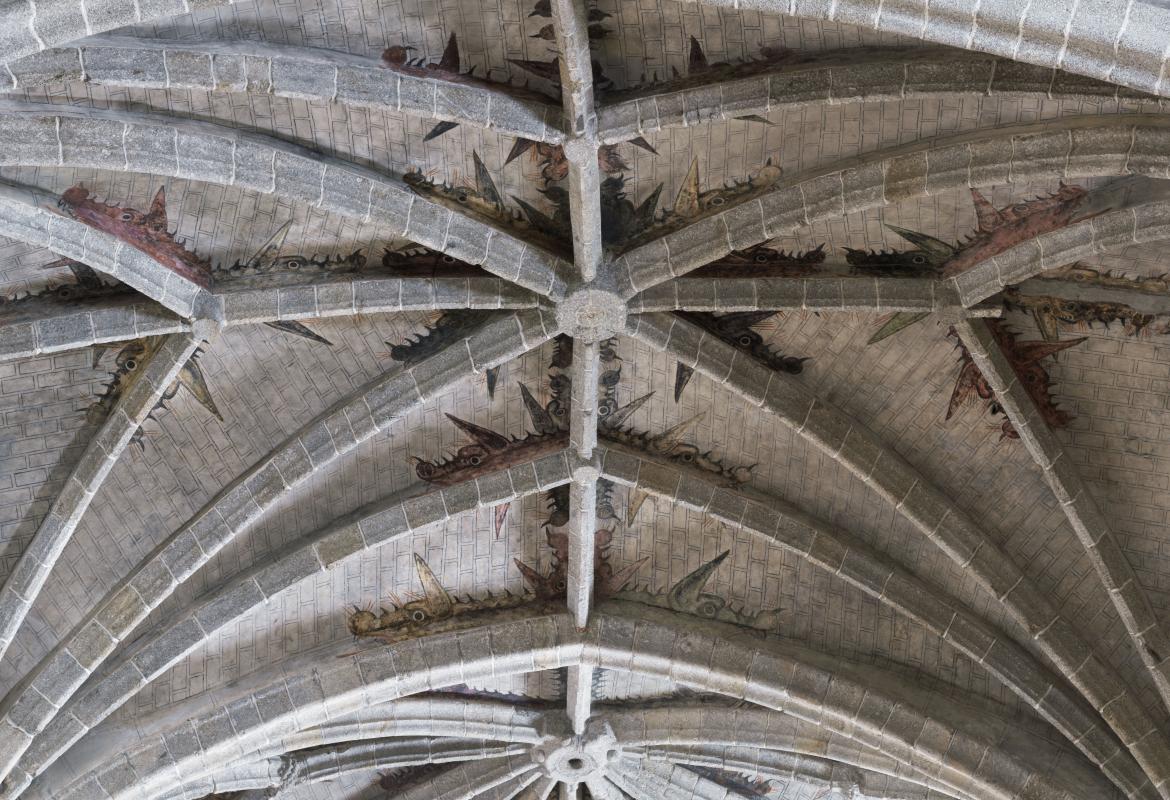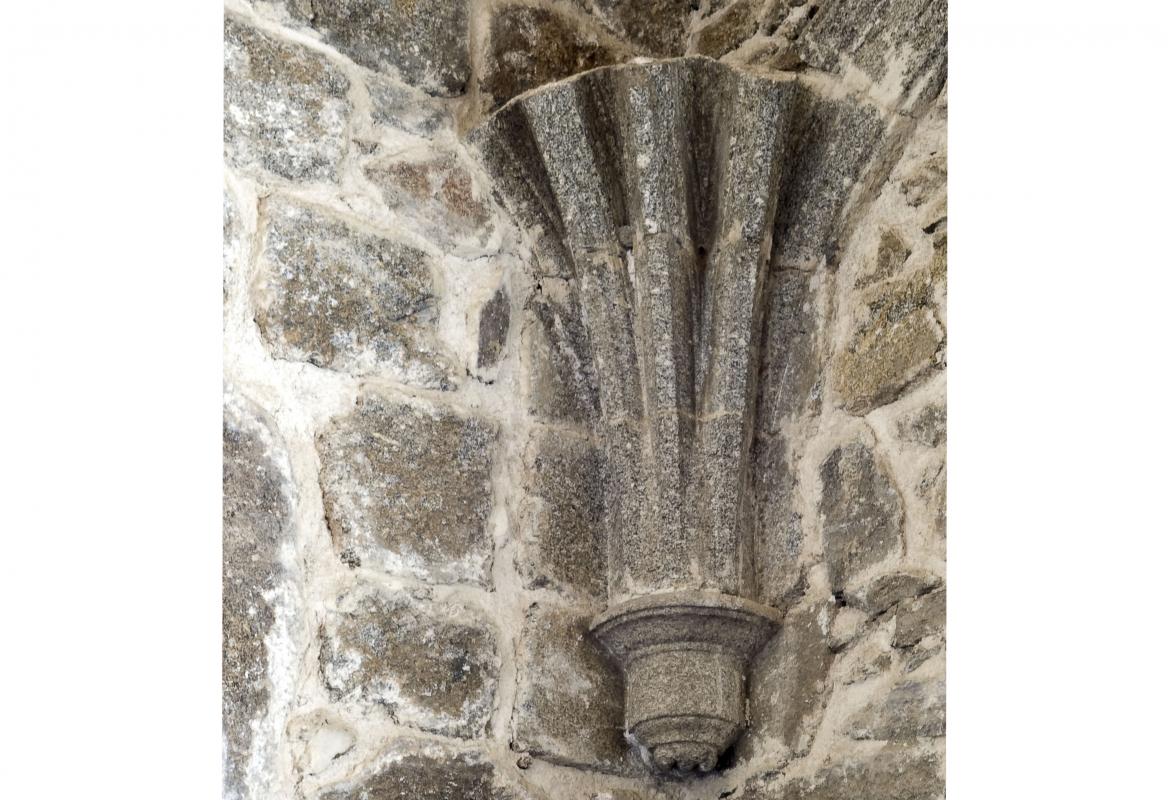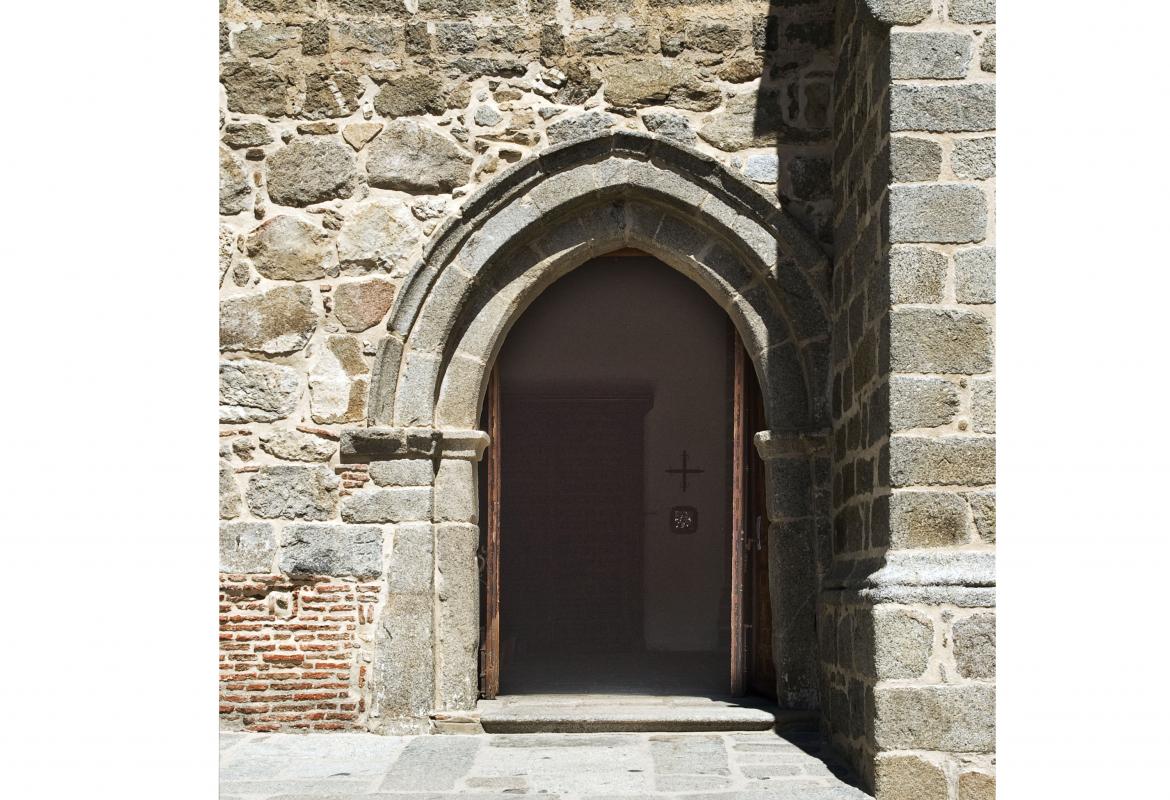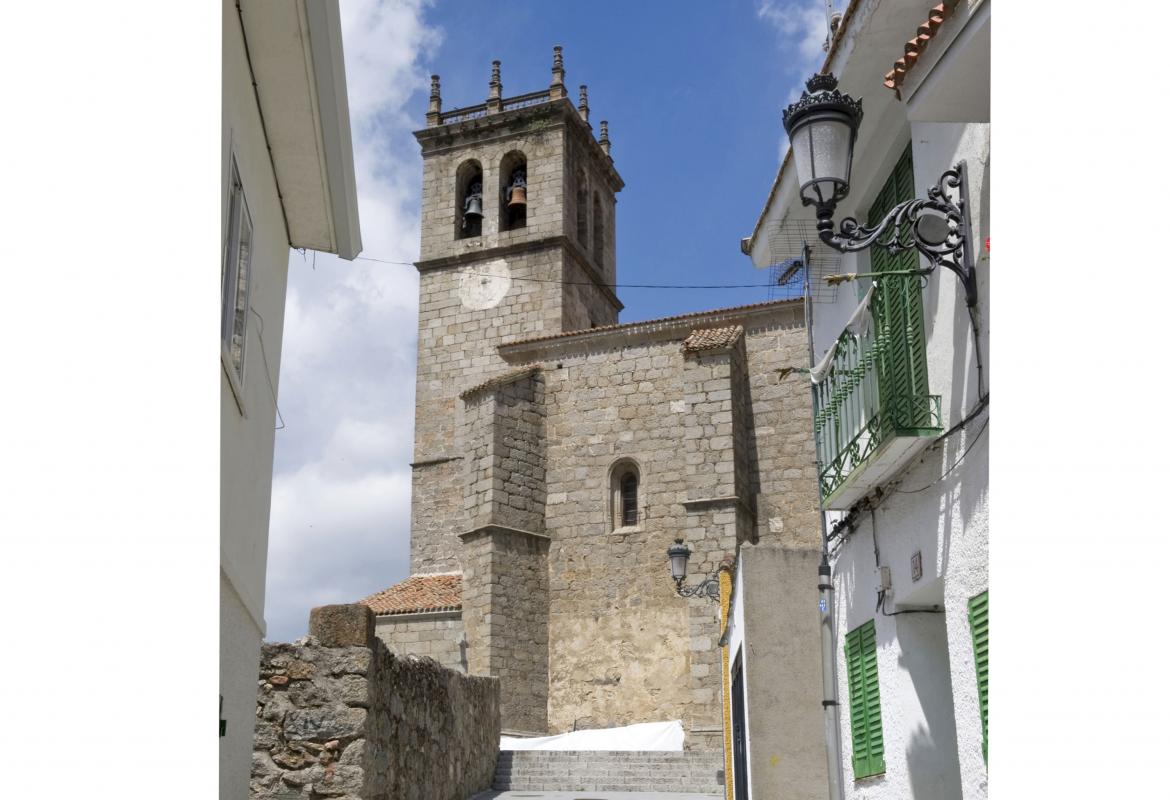




Parish Church of the Assumption of Our Lady of Robledo de Chavela
Asset of Cultural Interest in the category of Monument
Header image
Values that justify the declaration of the good
The church constitutes a magnificent expression of Castilian late Gothic architecture, especially related to the Avila workshops. Externally, it stands out for the use of granite stone and its monumental character, of great mass and sober, to which is added the appearance of a fortress that presents its head reinforced by buttresses topped with garitones. Inside it stands out the spatial conception of unity and spaciousness to which the roof system with starry vaults contributes, all of the same design, which cover the large nave that is more than fourteen meters wide.
Another element of great interest is the decoration with mural painting that covers the vaults of the headboard. In the plements, feigned ashlars are reproduced and the nerves are ornamented with pairs of dragon heads, constituting a series of almost eighty dragons that could be dated around 1500. In the Community of Madrid, so far this type of representations have been located in the vaults of the parish churches of Villalbilla and Villa del Prado, the latter contemporary and stylistically similar to those of Robledo.
At the head of the church stands out, both for its remarkable quality and for the scarce number of existing examples in the Community of Madrid, a Hispano-Flemish altarpiece of Toledo influence dedicated to the Assumption of the Virgin; It is made up of thirty-two oil panels that can be dated towards the end of the XNUMXth century or the beginning of the XNUMXth century, attributed to Antonio or Fernando del Rincón, painters in the service of the Catholic Monarchs and Cardinal Cisneros.
The parish church of the Assumption of Our Lady of Robledo de Chavela
The current church has a floor plan formed by a nave with three sections with an approximate width of 14 and a half meters, a straight front section like a transept that does not stand out in plan, but stands out for having a greater length, and a polygonal head of five sides that maintain the same width as the transept and the nave, which gives rise to a large rectangular space of considerable dimensions.
The layout of the plant is completed with a sacristy attached to the transept section on its south wall, with a rectangular floor plan, a chapel located in the first section of the nave on its north wall, and at the foot of the temple a large tower attached to the rectangular facade flanked by two rooms that are flush with the nave.
Externally, the church appears as a large volume in which the different construction phases that determined its current configuration are accused. On the north wall of the last section of the nave, a canvas can be seen that presents an irregular masonry factory on which another section is built, made up of large irregular granite blocks where a ashlar loophole is preserved. In the next section, built in masonry, there is a portal formed by a pointed and bent arch with a sharp edge profile, which rests on the stepped jambs by means of an impost with a nacelle profile; the arches are sheltered by a chambrane also with a nacelle profile that rests on the prolongation of the fascia of the arch; on the inside they have a lowered semicircular arch where the jambs of the original doors are located. On the arch there are three mechinales where a tejaroz would support; some of them are partially hidden by the buttresses built later, which could indicate the existence of a larger portico. On the south wall, the lower part of the three sections that make up the nave presents a concerted masonry factory. In the second section, the portal opens, with the same characteristics as the north portal, two loopholes (currently blinded), remains of an eaves with a nacelle profile supported by corbels in the shape of a ship's keel, four bezantes and caveto, and two gargoyles . Likewise, the lower part of the western wall, hidden by the tower, is built with a concerted masonry factory that seems to correspond to the primitive church.
Text_02
On the lower walls of the nave, new walls were subsequently erected on its north, south and west facades, made of irregular ashlar masonry, masonry on the south wall, ashlar on the north wall and ashlar on the west wall, which end in a cornice with Nacela profile that seems to be from a later invoice. They were reinforced by buttresses, two on the north and south walls and another two on the angles that they form with the west façade; made of ashlar of certain irregularity and thick grouting, they present a rectangular section that develops on a base that ends in a scribbled molding; at mid-height they are divided by means of an impost with a nacelle profile, to finish at the height of the cornice with a chamfered finish covered with Arabic tile.
The header and the previous section are made up of walls of concerted masonry made up of granite pieces of variable dimensions with mortar decorated with inlays of small pieces of iron slag that protrude from the mortar. It sits on a plinth, which adapts to the unevenness of the terrain, also made of concerted masonry, topped by a molding formed by a cord and a fourth round of ashlar masonry (currently it has a modern grouting, but possibly it would have slag decoration).
This area is reinforced by eight buttresses with a quadrangular plan executed with a masonry factory decorated with slag in the joints and pieces of ashlar masonry in the corners. In the lower part, these sit on a slightly highlighted plinth, from which the buttress develops in height, interrupted by a scribbled molding that is prolonged by the facings of the head and transept, until reaching a level where its profile changes to give rise to eight garitones of ultrasemicircular plant. They are cylindrical bodies built in granite ashlar masonry, in which a gargoyle is located on a bracket in each one of them, decorated at their base with a series of scribbled moldings. In the sections between the garitones there is a succession of lowered ashlar arches with a groined profile, which are supported by the perimeter walls and a quadrangular embrasure opens on the intrados. Above the arches and garitones there was a round walk with a higher wall as a parapet, the top of which has been greatly transformed, which gave the church the appearance of a fortress.
On the north façade, next to the last buttress of the straight section and protruding from the line of the wall, there is a spindle that houses a spiral staircase that leads to the back of the vaults of the head, and which originally would also communicate with the promenade round. Next to the spindle, at mid-height, there is a shallow machicolation with a loophole, which rests on two corbels with a quarter-round profile, whose function is unknown.
At the foot of the church on the axis there is a tower of more than 30 meters high, with a square plan built in ashlar masonry and ashlar. It is made up of four different bodies separated by impost lines, and ends in a body of bells with two semi-circular holes on three sides and one on the fourth, crowned by a balustrade with eight pinnacles on pedestals. It has a solid lower body of ashlar, pierced by a tunnel covered with a pointed half-barrel vault, made with well squared ashlars. The entrance is through a pointed arch located in the second body, four meters from the ground, which leads to a staircase that communicates with a room of remarkable height covered with a pointed half-barrel vault built with ashlar masonry; in it a Renaissance window opens. A stone staircase attached to the walls leads to the third body, crenellated, with thick buttresses (merlones) three meters high that supported a pyramidal wooden roof; two holes are opened in the north, east and west walls and one in the south wall.
Inside, the church has a large nave made up of three rectangular sections of different sizes, and a polygonal apse with five sides, partially hidden by a Spanish-Flemish altarpiece, preceded by a quadrangular section in the form of a transept, notable for having greater dimension than the sections of the ship. The entire church is covered with star ribbed vaults, which gives unity to the whole.
In elevation, internally the walls are smooth covered by a white plaster on which the painted roofs simulating ashlars, and the nerves, arches and supports attached to the walls made of granite stone stand out. Only the walls of the head and previous section are crossed by an impost that extends to the height of the tops of the capitals, with a profile made up of a simple outline.
Text_03
The lighting is done through five openings distributed irregularly along the walls of the church. Three in the head, one in the central section, currently blinded to the outside and hidden by the altarpiece inside, two in the north and south canvases of the main chapel, formed by a small semicircular hole sheltered by a semicircular arch with a sharp edge , with marked interior and exterior spillage on a sloping base; the bay located to the south was renovated in the XNUMXth century. Two other windows are located in the first and third sections of the south wall of the nave, constituted by a semicircular hole sheltered by a semicircular arch with a pronounced spill decorated with a succession of concave moldings, and in some cases with a baquetón that is It extends along the jambs as columns to rest on polygonal bases. At the northern end of the wall of the feet there is a narrow semicircular opening sheltered by an arch in pronounced overflow decorated by a succession of concave moldings.
The star-ribbed vaults all have the same design, which provides a continuous and uniform structure. They are made up of cross ribs, terceletes and cross ties in the center of the terceletes that extend to the vertex of the forming arches and girdles. The vault that covers the head is accommodated to the polygonal plan drawing half of an eight-pointed star, formed by six cross ribs, five tercelets and links that start from the central key to the vertex of the tercelets, the axis extending up to the vertex of the entrance arch, thus generating six keys, the central one formed by a large piece drilled in its center and decorated with the characteristic balls; the minor keys are decorated with bunches of grapes.
The plementery is made of brick arranged on the edge (brick screw vaults), while the nerves are made of granite added to the shell of the vault by the intrados (false). The profile of the ribs is practically the same throughout the church, with small variations due to the different crews that intervened in the work.
The arches and ribs rest on half columns attached to the walls, probably deliveries, which are broken up by drums of certain irregularity. The capitals of the columns of the head are formed by a small polygonal top with a bumpy profile, which is prolonged by the walls of the straight section and apse, and a short basket decorated with leaves of different types and somewhat rough treatment. The capitals corresponding to the columns of the nave show very slight variations with respect to those of the chevet: they are smaller in size and have a very short body of the capital decorated with leaf motifs, ending with another banded molding. The bases of the columns show the Attic version of the final Gothic, consisting of two banded moldings between which a slightly concave space of a certain height develops; These rest on a polygonal base that sits on a quadrangular pedestal from whose angles two bodies with a pyramidal profile emerge. The difference between those of the headboard and the nave lies in the reduction in the size of the body that is found between the two baquetones. The corbels where the nerves of the last section of the nave support, located at the angles, are semi-conical in profile, with a small semicircular abacus formed by a baquetón and a listel that leads to the field decorated with plant motifs, ending in a small piece muzzle and a ball.
The main altar, which is accessed by a stone staircase, is quite high, which allows a crypt to be located below, while allowing better visibility of the faithful from anywhere in the temple. In the front there is a large Hispanic-Flemish altarpiece, dating from around 1500, which hides the two corbels on which the ribs of the vault rest and which, apparently, are decorated with two unidentified coats of arms.
Learn more
Image gallery
Wall painting in the Community of Madrid
The publication collects the most representative of the rich heritage that constitutes the mural painting of our community, covering all historical periods, and compiling the most outstanding examples existing in cultural property of public and private ownership, both religious and civil. In total, it shows more than 150 representations, arranged chronologically and analyzed in detail.
Church of the Assumption of Our Lady, Robledo de Chavela
Absolutely exceptional due to their number and dimensions, the Robledo dragons are its most spectacular example in the territory of the Community of Madrid.
Built on a Romanesque temple from the thirteenth century, the church responds to the model of a single nave with four sections covered with vaults of terceletes and choir at the feet, characteristic of the reign of the Catholic Monarchs (1474-1504) and has been related to the architect Juan Gil de Hontañón. Its monumental head has a defensive character due to its powerful buttresses like cubes topped in turrets and the existence of a walkway. In 2012, during the restoration works, tastings were carried out in the whitewashed plementery of the vaults, which resulted in the progressive discovery of an impressive decorative series of almost eighty dragons, located in the semi-starred vault of the presbytery and in the immediate section the same.
Santiago Manzarbeitia Valley
Excerpt from the book Wall painting in the Community of Madrid



